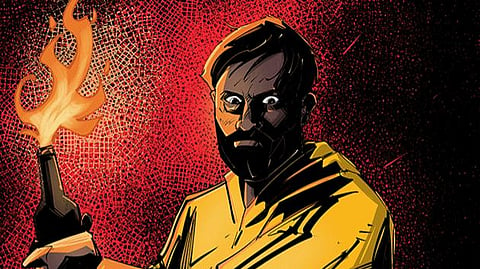Krishand’s The Art of Warfare demystifies gangsters, police through wicked humour
The Art of Warfare(3.5 / 5)
What’s the difference between pepper soda and lime water, Malayalam cinema and Marvel Cinematic Universe, Kerala police and a group of gangsters? The central ideas of Taoism says there’s a yin to a yang, a balance to every conflict, and a constant interplay of opposites that challenges conventional ideas of good and bad. Krishand uses this philosophical framework to question the politics of aesthetics and examine concepts of justice, identity, and the structures of power, positioning his new Malayalam film Sungsuvinte Sangharsha Ghadana or The Art of Warfare, based on Sun Tzu’s book, as a tragicomedy.
French filmmaker Francois Truffaut was of the view that it was impossible to make an anti-war film. To show something, he argued, is to ennoble it. Krishand combines snippets of history and geopolitics with some good old gangster tropes—established by classic Hollywood films such as The Godfather and Goodfellas—to avoid the conventional war film treatment in his film. He also playfully critiques the idiocracy of watching “mass” cinema in a world where there are several wars playing out in real time, invoking some of the most celebrated characters of Malayalam actor Mohanlal.
The story, on paper, is rather simple. A notorious gangster, Kodamazha Suni (played by a stoic Sanup Padavedan), has retired. A new gang in town, led by a vengeful Kunjan (Vishnu Agasthya), attacks members of his gang, leading to the resurfacing of a long-dormant conflict. However, it is translated onto the screen in the most imaginative way, using montages of historical trivia. Situations are created by juxtaposing the lives of these gangsters with several geopolitical events that changed the world. The abduction of a child is equated with the war in Syria, difficulties in cremating a dead body is overlapped with the ongoing genocide in Palestine.
While the story is mainly about the character played by Sanup, it is the supporting characters that add depth to his life in the film. Perhaps the most notable is his rival, played by Vishnu, who delivers a breakout performance after his appearance in the Malayalam film RDX. Zhinz Shan plays Sethumadhavan, a dependable man who thinks with the heart rather than the brain amid the brutality. Circle Inspector Sudha, played by Mrudula Murali, feels like a properly fleshed out character in a film that mostly revolves around the life of men. Her screen presence and comedic interventions are a treat to watch.
Following a non-linear structure of storytelling, The Art of Warfare explores the moral question of certain aesthetic parameters set by the society for gangsters—such as long beards, secret meetings, and weapons, among other things. While sticking to these clichés, Krishand infuses humour to demystify the glamour around antagonism in the society. The death wish of a retired gangster is not to seek revenge, but to drink pepper soda and eat masala dosa. Another member of the gang feels miffed that the quotation work is taking time since he has to go to work the next day.
The depiction of police officers has been the director’s forte in all of his films, and this is once again reflected in The Art of Warfare. An interrogation scene between a police officer and a gangster is perhaps the funniest political humour Malayalam cinema has produced in a long time. Other exchanges between the police and gangsters create a tension that escalates the stakes of otherwise ordinary situations.
The film is also highly deceptive in nature, toying with the soundscape and using frames that feel like a cut-and-paste from popular filmmakers such as Wong Kar Wai and Akira Kurosawa. As in his previous films, Krishand ensures that this influence is acknowledged in the post-credits. Cinematographer Prayag Mukundan and music director Rajesh Naroth’s exceptional skills justify the nod to these veteran filmmakers. The subtitling is another aspect that ensures the film caters to both the local and international audience.
Krishand envisaged this as a commercial theatrical flick at the 29th International Film Festival of Kerala (IFFK). For me, an afterthought upon leaving the theatre was whether I retained all of the information presented in a film that displayed immense political clarity. Due to its dual visual narratives running side by side, it may take a few revisits to fully appreciate the essence of the idea.
Disclaimer: This review was not paid for or commissioned by anyone associated with the series/film. TNM Editorial is independent of any business relationship the organisation may have with producers or any other members of its cast or crew.

